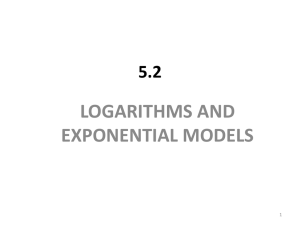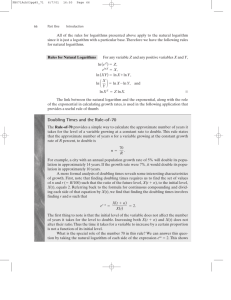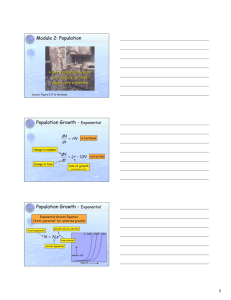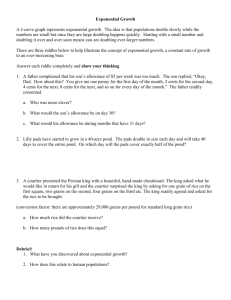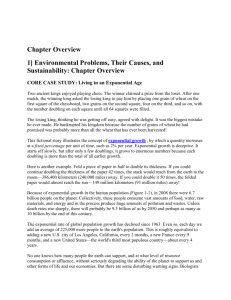Exponential Growth and The Rule of 70
advertisement
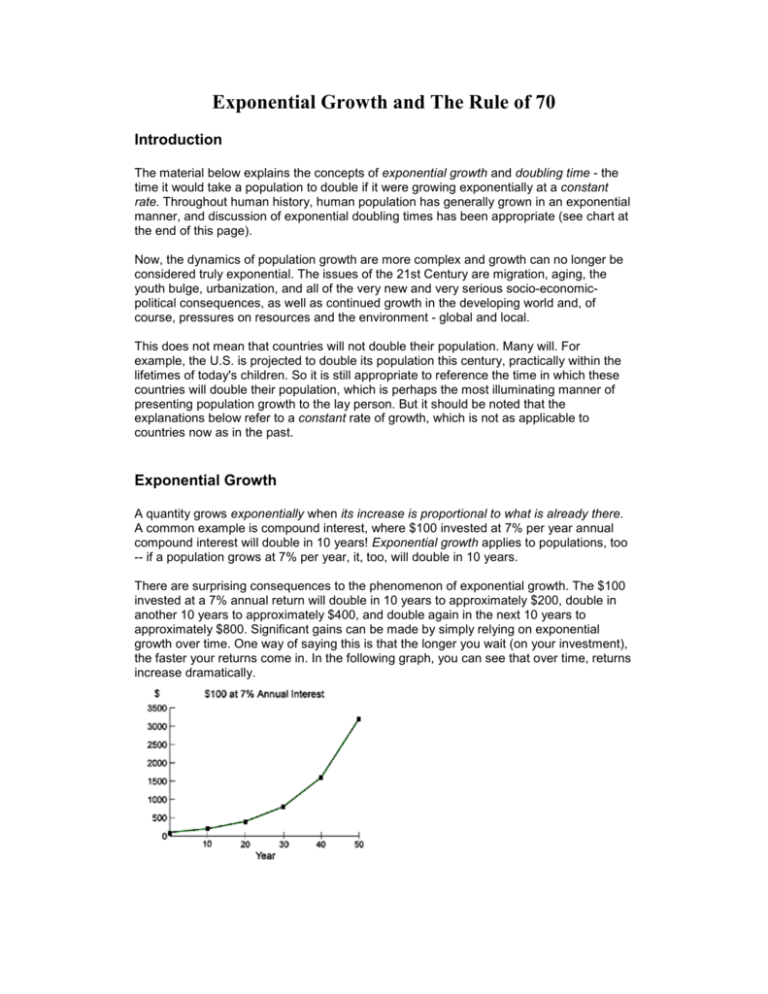
Exponential Growth and The Rule of 70 Introduction The material below explains the concepts of exponential growth and doubling time - the time it would take a population to double if it were growing exponentially at a constant rate. Throughout human history, human population has generally grown in an exponential manner, and discussion of exponential doubling times has been appropriate (see chart at the end of this page). Now, the dynamics of population growth are more complex and growth can no longer be considered truly exponential. The issues of the 21st Century are migration, aging, the youth bulge, urbanization, and all of the very new and very serious socio-economicpolitical consequences, as well as continued growth in the developing world and, of course, pressures on resources and the environment - global and local. This does not mean that countries will not double their population. Many will. For example, the U.S. is projected to double its population this century, practically within the lifetimes of today's children. So it is still appropriate to reference the time in which these countries will double their population, which is perhaps the most illuminating manner of presenting population growth to the lay person. But it should be noted that the explanations below refer to a constant rate of growth, which is not as applicable to countries now as in the past. Exponential Growth A quantity grows exponentially when its increase is proportional to what is already there. A common example is compound interest, where $100 invested at 7% per year annual compound interest will double in 10 years! Exponential growth applies to populations, too -- if a population grows at 7% per year, it, too, will double in 10 years. There are surprising consequences to the phenomenon of exponential growth. The $100 invested at a 7% annual return will double in 10 years to approximately $200, double in another 10 years to approximately $400, and double again in the next 10 years to approximately $800. Significant gains can be made by simply relying on exponential growth over time. One way of saying this is that the longer you wait (on your investment), the faster your returns come in. In the following graph, you can see that over time, returns increase dramatically. Unfortunately, exponential growth works against us, too. When populations continue to grow, the impact of growth becomes increasingly significant over time. In other words, because of the nature of exponential growth, "when things get bad, they get bad in a hurry". Consider a country with 100 people, growing at 7% per year. In 10 years, the population will double to 200 people, in another 10 years it will double again to 400 people, and ten years after that it will double again to 800 people. The following graph shows this exponential population growth. Notice the shape of the curve is the same as in the graph above! The Lily Pond Parable 1. If a pond lily doubles everyday and it takes 30 days to completely cover a pond, on what day will the pond be 1/4 covered? 2. 1/2 covered? 3. Does the size of the pond make a difference? 4. What kind of environmental consequences can be expected as the 30th day approaches? 5. What will begin to happen at one minute past the 30th day? 6. At what point (what day) would preventative action become necessary to prevent unpleasant events? 7. With respect to human population, what corresponding day are we at in the world? The United States? APES: DEMOGRAPHIC FACTS OF LIFE ACTIVITY (From Earth Matters) PART I: Doubling Time Birth and death rates determine the rate of population growth. If the birth and death rates are similar, a population experiences little or no growth. When the birth rate far exceeds the death rate, the population soars. These rates are expressed as the number of births or deaths for every 1,000 people in a given year. For instance, in 1998 the world's birth rate was 23 per 1,000 and the death rate was 9 per 1,000. Using the formulas below, we can determine the world's annual growth rate and the number of years it will take the population to double if the growth rate remains constant. % annual natural increase = birth rate - death rate 10 23 - 9 = 1.4% 10 doubling time (in years) = 70/rate of increase 70 = 50 years 1.4% PROCEDURE: Fill in Student Worksheet 1 and answer the discussion questions below. Student Worksheet #1 Birth Rate in 2013 Death Rate % Annual Doubling (per 1000 in 2013 (per Natural Time (in people) 1000 people) Increase Years) Country China 12 7 India 20 8 Iraq 28 5 Italy 9 10 Japan 8 10 Kenya 30 9 Mexico 19 4 Russia 12 14 South Africa 19 14 Unite Kingdom 12 9 United States 14 8 Afganistan 39 8 Indonesia 17 6 DISCUSSION: 1) Why do you think some countries are doubling much more rapidly than others? Why do you think some countries, such as Italy, have reached zero population growth? 2) Which figures differ most greatly between countries, the birth rates or the death rates? How would you explain the wide disparity in birth rates among different countries? Why are death rates relatively low in many countries with high birth rates? 3) a. If you were a national leader in Kenya or Iraq, would you be concerned about the rapid population growth? b. Why or why not? c. Similarly, if you were national leader in Italy, would you be concerned that your country has reached zpg? d. Why or why not? 4) The population of the U.S. is actually growing at the rate of about 1 percent each year, more than its rate of natural increase. Where is the additional population growth coming from? Part II: Grim Reaper's Revenge Conveying the importance of population figures can be difficult since the numbers are so large they lose their meaning. Fill in the chart below to be amazed! Below is a listing of some of the world's worst disasters, along with an approximate death toll. At today's present rate of growth, determine how many days and it would take to replace those lost. Round off to one decimal place. We are currently adding 84 million people (net growth) to the world each year, or 229,000 people each day Approximate # of Deaths Present world population growth replace this # in how many days and hours? Some Past Disasters Bangledeshi cyclone, 1991 140,000 Total deaths by injury in 180,811 the U.S. 2012 Total American deaths in all wars 600,000 Great flood, Hwang Ho River, 1887 900,000 HIV related deaths in 2011 1,700,000 Total US automobile deaths through 1995 2,600,000 India famine, 1769-70 3,000,000 China famine, 1877-78 9,500,000 Influenza epidemic, 1918 21,000,000 Global deaths in all wars in the past 500 years 35,000,000 Bubonic plague, 1347-51 75,000,000 This assignment was adapted from an activity Mary Beth Kircher and Sam Rhee of Bryn Mawr School The Rule of 70 The Rule of 70 is useful for financial as well as demographic analysis. It states that to find the doubling time of a quantity growing at a given annual percentage rate, divide the percentage number into 70 to obtain the approximate number of years required to double. For example, at a 10% annual growth rate, doubling time is 70 / 10 = 7 years. Similarly, to get the annual growth rate, divide 70 by the doubling time. For example, 70 / 14 years doubling time = 5, or a 5% annual growth rate. The following table shows some common doubling times: Growth Rate Doubling Time (% per Year) in Years 0.1 700 0.5 140 1 70 2 35 3 23 4 18 5 14 6 12 7 10 10 7 Math Behind the Rule of 70 The use of natural logs arises from integrating the basic differential equation for exponential growth: dN/dt = rN, over the period from t=0 to t = the time period in question, where N is the quantity growing and r is the growth rate. The integral of that equation is: rt N(t) = N(0) x e where N(t) is the size of a quantity after t intervals have elapsed, N(0) is the initial value of the quantity,e is the base of the natural logarithm, r is the average growth rate over the interval in question, and t is the number of intervals. Natural logarithms (that is, logarithms to the base e) come in from this integration. Natural logs are sometimes abbreviated ln to distinguish them from "common" logarithms of base 10. In our case, t is usually given in years and r is the average annual growth rate. However, the formula works for seconds, weeks, centuries, etc. rt The ratio of the final to the initial values of N is N(t)/N(0), and is equal to e power. (Dividing through by N(0).) The natural logarithm of the ratio N(t)/N(0) is equal to rt. (Taking the natural log of e raised to a power is simply the power itself.) The growth rate r is then given by natural log N(t)/N(0) divided by t. Alternatively, if one knows the final and initial values of N and the average growth rate, one can find the time it takes at that average growth rate for the quantity to grow from its initial value to the final value. t = ln [ N(t)/N(0) ] / r A special case is the doubling time, which is the time when N(t)/N(0) = 2, that is the quantity has doubled from its initial value. At that point rt = ln 2 = 0.69 If one knows the growth rate as a decimal fraction, then the doubling time t2 = 0.69 / r. If the growth rate is given in percent, then 0.69 must be multiplied by 100, and the doubling time = 69/r. This is the origin of the rule of 70, i.e., 69 is rounded up to 70. For the results to be accurate, all of these calculations assume that the growth rate remains unchanged throughout the interval in question, that is, that the growth is exponential at the average rate for the entire period. Most quantities don't really grow that way (compound interest is an exception), so this method is generally an approximation for the real world. When considering growth over a period of years, it is important to note that taking the natural logarithm of the ratio of the final value to the initial value and dividing by the time period in years gives the average annual growth rate. For example, metro Denver population grew 15% from 1990 to 1996. The simple arithmetic average of growth is 2.5% per year (15% / 6 years = 2.5%/year). Strictly speaking the rule of 70 applies to exponential growth, which means that the compound average population growth rate must be divided into 70 to get the doubling time. The compound average growth rate involves natural logarithms. To find the compound growth rate, take the natural log of the ratio of the final to the initial populations and divide this by 6 years. 15% growth means that the ratio of final to initial populations is 1.15. (The final population is 115% of the initial population, considered to be 100%; 115% / 100% = 1.15.) The natural log of 1.15 is 0.14. Dividing 0.14 by 6 years = 0.023/year, or an average geometric increase of 2.3% / year. Finally, divide 70 by 2.3 to give a doubling time of 30 years. -- Mathematical explanation by Dick Schneider Copyright 1995-2003 Fred Elbel. This material may be freely used and distributed only for non-commercial purposes, with credit. Trademarks and copyrighted items remain the property of the owner. Additional References Algebra the Easy Way, Douglass Downing; 1996, ISBN 0812093933, (334p, $11). Includes a basic discussion of exponential functions and logarithms. Ask. Dr. Math Beyond the Limits, Confronting Global Collapse, Envisioning a Sustainable Future, Donella Meadows. The first two chapters present an excellent discussion of exponential growth. Doubling Times and the Rule of 70, Mathematical Methods for Economics, Michael Klein. Is There A Population Problem?, Albert A. Bartlett. Population Doubling Time, Population-Environment Balance. Back to Population and Sustainability | Population Information | EcoFuture ™ home Copyright 1995-2003 Fred Elbel. This material may be freely used and distributed only for non-commercial purposes, with credit. Trademarks and copyrighted items remain the property of the owner.
